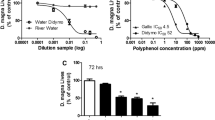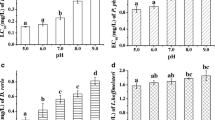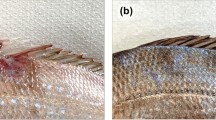Abstract
Daphnia has been widely used as an indicator species in aquatic biomonitoring for decades. Traditional toxicity assays based on lethality take a long time to assess, and the effect mode of contaminants is not clear. Because of the translucency of the Daphnia body and the application of fluorescent probes in cell staining, different intoxicated parts can be visualized. In this study, a double-staining method using two fluorescent dyes, Calcein AM (cell-permeant dye) and Propidium Iodide (cell-impermeant dye), was carried out on Daphnia magna exposed to six pathogens: Salmonella spp. (four strains) and Shigella spp. (two strains). The results showed that those bacteria caused different infections on daphnia depending on the age of this organism and bacterial concentrations. In detail, S. dublin and S. sonnei are the most harmful to Daphnia when they cause damage at smaller concentrations at the younger stage (3 weeks old). Interestingly, older Daphnia can give responses to nearly 10 CFU/ml to less than 100 CFU/ml of some bacteria strains. In another experiment, S. sonnei disturbed Daphnia after just 10 min of exposure, and Daphnia adapted to S. choleraesuis, S. typhi, and S. flexneri at the early stage (3 weeks old) after 1 h of exposure. Moreover, the damaged areas of the daphnia body were directly observed via a microscope, contributing to the understanding and the prediction of toxicity mechanisms.





Similar content being viewed by others
References
Barata C, Navarro JC, Varo I, Riva MC, Arun S, Porte C (2005) Changes in antioxidant enzyme activities, fatty acid composition and lipid peroxidation in Daphnia magna during the aging process. Comp Biochem Physiol Part B: Biochem Mol Biol 140:81–90
Bruns E, Carson M, May G (2012) Pathogen and host genotype differently affect pathogen fitness through their effects on different life-history stages. BMC Evolut Biol 12:1
Burton EA, Pendergast AM, Aballay A (2006) The Caenorhabditis elegans ABL-1 tyrosine kinase is required for Shigella flexneri pathogenesis. Appl Environ Microbiol 72:5043–5051
Cáceres C, Davis G, Duple S, Hall S, Koss A, Lee P, Rapti Z (2014) Complex Daphnia interactions with parasites and competitors. Math Biosci 258:148–161
Constantinou J, Sullivan J, Mirbahai L (2019) Ageing differently: sex-dependent ageing rates in Daphnia magna. Exp Gerontol 121:33–45
Duneau D, Luijckx P, Ben-Ami F, Laforsch C, Ebert D (2011) Resolving the infection process reveals striking differences in the contribution of environment, genetics and phylogeny to host-parasite interactions. BMC Biol 9:11. https://doi.org/10.1186/1741-7007-9-11
Ebert D (2008) Host–parasite coevolution: insights from the Daphnia—parasite model system. Curr Opin Microbiol 11:290–301
Feasey NA, Dougan G, Kingsley RA, Heyderman RS, Gordon MA (2012) Invasive non-typhoidal salmonella disease: an emerging and neglected tropical disease in Africa. Lancet 379:2489–2499
Felix TM, Hughes KA, Stone EA, Drnevich JM, Leips J (2012) Age-specific variation in immune response in Drosophila melanogaster has a genetic basis. Genetics 191:989–1002
Hoornstra D, Andersson M, Mikkola R, Salkinoja-Salonen M (2003) A new method for in vitro detection of microbially produced mitochondrial toxins. Toxicol Vitr 17:745–751
Jääskeläinen E et al. (2003) In vitro assay for human toxicity of cereulide, the emetic mitochondrial toxin produced by food poisoning Bacillus cereus. Toxicol Vitr 17:737–744
Kesika P, Karutha Pandian S, Balamurugan K (2011) Analysis of Shigella flexneri-mediated infections in model organism Caenorhabditis elegans. Scand J Infect Dis 43:286–295
Khan I, Prasad N(2013) Aging immune response Drosoph melanogaster J Gerontol Ser A: Biol Sci Med Sci 68:129–135
Labbé P, Vale PF, Little TJ (2010) Successfully resisting a pathogen is rarely costly in Daphnia magna. BMC Evolut Biol 10:1
Labrousse A, Chauvet S, Couillault C, Kurz CL, Ewbank JJ (2000) Caenorhabditis elegans is a model host for Salmonella typhimurium. Curr Biol 10:1543–1545
Lampert W (2011) Daphnia: development of a model organism in ecology and evolution, vol 21. International Ecology Institute Oldendorf, Luhe
Laws TR, Harding SV, Smith MP, Atkins TP, Titball RW (2006) Age influences resistance of Caenorhabditis elegans to killing by pathogenic bacteria. FEMS Microbiol Lett 234:281–287. https://doi.org/10.1111/j.1574-6968.2004.tb09545.x
Martins NE, Faria VG, Teixeira L, Magalhães S, Sucena É (2013) Host adaptation is contingent upon the infection route taken by pathogens. PLoS Pathog 9:e1003601
McTaggart SJ, Wilson PJ, Little TJ (2012) Daphnia magna shows reduced infection upon secondary exposure to a pathogen. Biol Lett 8:972–975
Melissa Z, Ephat H, Neal S, Marc T (2005) Aging of the innate immune response in Drosophila melanogaster. Aging Cell 4:103–108. https://doi.org/10.1111/j.1474-9728.2005.00147.x
Molinas A, Sicard G, Jakob I (2012) Functional evidence of multidrug resistance transporters (MDR) in rodent olfactory epithelium. PLoS ONE 7(5):e36167
Möst M, Chiaia‐Hernandez AC, Frey MP, Hollender J, Spaak P (2015) A mixture of environmental organic contaminants in lake sediments affects hatching from Daphnia resting eggs. Environ Toxicol Chem 34:338–345
Newell DG et al. (2010) Food-borne diseases—the challenges of 20 years ago still persist while new ones continue to emerge. Int J food Microbiol 139:S3–S15
Oda S, Kato Y, Watanabe H, Tatarazako N, Iguchi T (2011) Morphological changes in Daphnia galeata induced by a crustacean terpenoid hormone and its analog. Environ Toxicol Chem 30:232–238
Olson DP, Taylor BJ, Ivy SP (2001) Detection of MRP functional activity: calcein AM but not BCECF AM as a Multidrug Resistance-related Protein (MRP1) substrateJ Int Soc Anal Cytol 46:105–113
Pestana JL, Loureiro S, Baird DJ, Soares AM (2010) Pesticide exposure and inducible antipredator responses in the zooplankton grazer, Daphnia magna Straus. Chemosphere 78:241–248
Prasai K, Karlsson B (2012) Variation in immune defence in relation to age in the green-veined white butterfly (Pieris napi L.). J Invertebr Pathol 111:252–254
Sineva EV et al. (2009) Expression of Bacillus cereus hemolysin II in Bacillus subtilis renders the bacteria pathogenic for the crustacean Daphnia magna. FEMS Microbiol Lett 299:110–119
Soetaert A, Moens LN, Van der Ven K, Van Leemput K, Naudts B, Blust R, De Coen WM (2006) Molecular impact of propiconazole on Daphnia magna using a reproduction-related cDNA array. Comp Biochem Physiol Part C: Toxicol Pharmacol 142:66–76
Teplova VV, Andreeva‐Kovalevskaya ZI, Sineva EV, Solonin AS (2010) Quick assessment of cytotoxins effect on Daphnia magna using in vivo fluorescence microscopy. Environ Toxicol Chem 29:1345–1348
Tsolis RM, Xavier MN, Santos RL, Bäumler AJ (2011) How to become a top model: impact of animal experimentation on human Salmonella disease research. Infect Immun 79:1806–1814
Viegas SC, Mil-Homens D, Fialho AM, Arraiano CM (2013) The virulence of Salmonella enterica Serovar Typhimurium in the insect model galleria mellonella is impaired by mutations in RNase E and RNase III. Appl Environ Microbiol 79:6124–6133
Weber CI (1991) Methods for measuring the acute toxicity of effluents and receiving waters to freshwater and marine organisms. Environmental Monitoring Systems Laboratory, Office of Research and Development, US Environmental Protection Agency. Cincinnati, Ohio, United States
Funding
This research was supported by Basic Science Research Program through the National Research Foundation of Korea(NRF) funded by the Ministry of Education (2020R1A6A1A06046235).
Author information
Authors and Affiliations
Corresponding authors
Ethics declarations
Conflict of interest
The authors declare that they have no conflict of interest.
Additional information
Publisher’s note Springer Nature remains neutral with regard to jurisdictional claims in published maps and institutional affiliations.
Rights and permissions
About this article
Cite this article
Le, V.Q.A., Choi, W., Kim, T. et al. In vivo assessment of pathogens toxicity on Daphnia magna using fluorescent dye staining. Ecotoxicology 29, 892–899 (2020). https://doi.org/10.1007/s10646-020-02257-6
Accepted:
Published:
Issue Date:
DOI: https://doi.org/10.1007/s10646-020-02257-6




